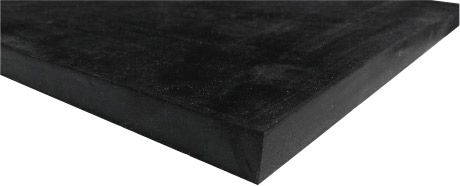
PTFE-surfaced neoprene-backed slide bearings are also available. Type CSA material is recommended bonded to a 10-gauge steel laminate which has been bonded to neoprene.
If minimum dead load pressure is less than 200 psi, it is recommended that the elastomer be epoxy-bonded to concrete. If being welded on steel, an 8 gauge tack plate is recommended for positive reinforcement and ease of application. The maximum temperature at a neoprene bearing is 200° F.

Natural Rubber Elastomeric Bearings are made of an elastomer containing either natural rubber as the basic polymer. They are available primarily in 55 durometer hardness (Shore A) and meet the CAN/CSA-S6-06 standard, or in hardness meeting Ontario OPSS 1202. They can be molded or cut (from standard rolls) into a wide range of dimensions and thicknesses.
| Property | Test Method | Results |
|---|---|---|
| Rubber Type = Natural | ||
| Hardness, Shore A | D2240 | 55 +- 5 |
| Tensile Strength, MPa | D412 | Minimum 17.0 |
| Ultimate Elongation, % | D412 | Minimum 400 |
| Specified Test Temperature | D573 | 70h at 70 degrees C |
| Change in Hardness, Shore A | D573 | Maximum + 10 |
| Change in Tensile Strength, % | D573 | Maximum -25 |
| Change in Ultimate Elongation, % | D573 | Maximum - 25 |
| Specified Test Temperature | D395 | 22 h at 70 Degrees C |
| Residual Compression, % | D395 | Maximum 25 |
| Mounting Procedure A | D1149 | 22 pphm, 48 h |
| 20% Strain, 40 +- 2 Degrees C | D1149 | No cracks |
| Bond Between Steel and Elastomer Laminate, N,mm | D429 | Minimum 7.0 |
| Brittleness at -10 degrees C | D746 | No Failure |
| Low Temperature Crystallization Increase in Hardness, Shore A | D2240 | 168 h at -25 Degrees C Maximum + 15" |
Data given is from CAN/CSA-S6-06
Other hardness and other grades are available to meet AASHTO, AREMA or other standards as per engineer requirements.
Maximum shear deformation of a plain bearing pad is limited to 50% of
the total pad thickness
For plain bearing pads used under compressive load only, i.e. without
rotation, the maximum pad thickness can be obtained from a graph
relating the average service compressive load to the pad shape factor.
It should be noted that a positive attachment should be specified for
minimum compressive loads of less than 1.5 MPa at SLS (Serviceability Limit State).